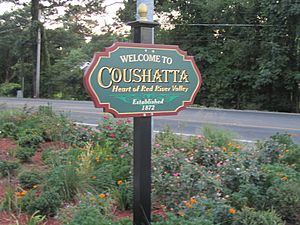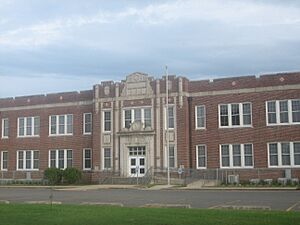Coushatta, Louisiana facts for kids
Quick facts for kids
Coushatta, Louisiana
|
|
|---|---|
| Town of Coushatta | |
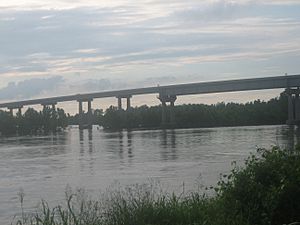
The Red River at Coushatta
|
|
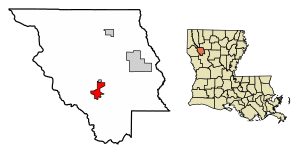
Location of Coushatta in Red River Parish, Louisiana.
|
|
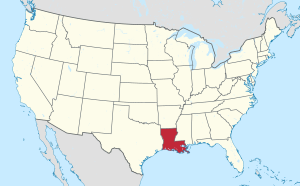
Location of Louisiana in the contiguous United States
|
|
| Country | United States |
| State | Louisiana |
| Parish | Red River |
| Area | |
| • Total | 3.44 sq mi (8.90 km2) |
| • Land | 3.34 sq mi (8.65 km2) |
| • Water | 0.10 sq mi (0.25 km2) |
| Elevation | 141 ft (43 m) |
| Population
(2020)
|
|
| • Total | 1,752 |
| • Density | 524.55/sq mi (202.52/km2) |
| Time zone | UTC-6 (CST) |
| • Summer (DST) | UTC-5 (CDT) |
| Zip Code |
71019
|
| Area code(s) | 318 |
| FIPS code | 22-18055 |
Coushatta is a town in northern Louisiana, United States. It is the main town and parish seat of Red River Parish. The town is located on the east bank of the Red River. It is about 45 miles south of Shreveport on U.S. Highway 71. In 2020, about 1,752 people lived there. The town gets its name from the Coushatta, a Native American group who originally lived in this area.
Contents
History of Coushatta
After the Civil War, the Red River Parish area, including Coushatta, saw a lot of trouble. This was especially true during the 1870s, a time known as Reconstruction. The area was known for growing cotton, and many African Americans who had been enslaved lived there. After they gained their freedom, they tried to build new lives. White farmers and landowners, however, wanted to keep control.
In May 1874, a group called the White League formed in Louisiana. They were well-organized in places like Red River Parish. Their goal was to make it harder for African Americans to vote and to take away their civil rights. They used violence against elected officials and tried to stop people from voting, especially African Americans and white Republicans.
One sad event happened in August 1874. The White League captured six Republican officials in Coushatta. They forced these officials to promise to leave the state. As the officials were leaving, they were attacked. Among the victims were the brother and three brothers-in-law of a state senator named Marshall H. Twitchell. The White League also attacked several freedmen who were with the officials. This event is known as the Coushatta Massacre. It led the governor to ask the U.S. President, U.S. Grant, for more federal soldiers to help control the state.
After this period of violence, a group called "Redeemer Democrats" gained control of the state government by 1876. They made new laws and a new constitution that made it very difficult for most African Americans and many poor white people to vote. This unfair system lasted for many decades until new civil rights laws were passed in the 20th century, like the Voting Rights Act of 1965.
After World War II, a doctor named Lawrence Edward L'Herisson, Sr., built a hospital in Coushatta. Today, the town is served by the Christus Coushatta Health Care Center, which has 25 beds.
Geography and Climate
Coushatta covers a total area of about 3.4 square miles (8.9 square kilometers). Most of this area is land, with a small part being water.
North of Coushatta, a bayou called Loggy Bayou flows into the Red River.
Weather in Coushatta
Coushatta has a humid subtropical climate. This means it has warm to hot and often humid summers. The winters are usually mild.
| Climate data for Coushatta, Louisiana | |||||||||||||
|---|---|---|---|---|---|---|---|---|---|---|---|---|---|
| Month | Jan | Feb | Mar | Apr | May | Jun | Jul | Aug | Sep | Oct | Nov | Dec | Year |
| Mean daily maximum °F (°C) | 61 (16) |
64 (18) |
71 (22) |
77 (25) |
84 (29) |
89 (32) |
91 (33) |
91 (33) |
88 (31) |
80 (27) |
71 (22) |
63 (17) |
78 (26) |
| Mean daily minimum °F (°C) | 41 (5) |
44 (7) |
51 (11) |
57 (14) |
66 (19) |
72 (22) |
74 (23) |
74 (23) |
69 (21) |
59 (15) |
50 (10) |
43 (6) |
58 (14) |
| Average precipitation inches (mm) | 5.5 (140) |
3.3 (84) |
3.5 (89) |
3.6 (91) |
6.1 (150) |
6.1 (150) |
5.1 (130) |
4.8 (120) |
6 (150) |
3.9 (99) |
4.6 (120) |
4.6 (120) |
57.2 (1,450) |
| Source: Weatherbase | |||||||||||||
Population Facts
| Historical population | |||
|---|---|---|---|
| Census | Pop. | %± | |
| 1880 | 488 | — | |
| 1890 | 619 | 26.8% | |
| 1900 | 600 | −3.1% | |
| 1910 | 564 | −6.0% | |
| 1920 | 962 | 70.6% | |
| 1930 | 959 | −0.3% | |
| 1940 | 1,289 | 34.4% | |
| 1950 | 1,788 | 38.7% | |
| 1960 | 1,663 | −7.0% | |
| 1970 | 1,492 | −10.3% | |
| 1980 | 2,084 | 39.7% | |
| 1990 | 1,845 | −11.5% | |
| 2000 | 2,299 | 24.6% | |
| 2010 | 1,964 | −14.6% | |
| 2020 | 1,752 | −10.8% | |
| U.S. Decennial Census | |||
Here's a look at the different groups of people living in Coushatta as of 2020:
| Race | Number | Percentage |
|---|---|---|
| White (non-Hispanic) | 465 | 26.54% |
| Black or African American (non-Hispanic) | 1,175 | 67.07% |
| Native American | 6 | 0.34% |
| Other/Mixed | 51 | 2.91% |
| Hispanic or Latino | 55 | 3.14% |
In 2020, there were 1,752 people living in Coushatta. They lived in 856 households, with 541 of those being families.
Economy and Community
Coushatta is home to a military unit called C Troop 2-108th Cavalry Squadron. This unit has a long history, dating back to the Civil War. They were known as "the Wildbunch." This unit has served in Iraq twice, once in 2004–2005 and again in 2010.
Education in Coushatta
Students in Coushatta and all of Red River Parish attend schools run by the Red River Parish School District. The schools include:
- Red River Elementary School (for grades PK–5)
- Red River Junior High School (for grades 6–8)
- Red River Senior High School (for grades 9–12)
Coushatta also has Magnolia Bend Academy, which offers both in-person and at-home learning options for grades PK-12.
Media
The local newspapers in Coushatta are The Coushatta Citizen and Red River Parish Journal. There is also a radio station, KRRP, which plays gospel music.
Famous People from Coushatta
Many notable people have connections to Coushatta:
- Joe Adcock – A famous baseball player for the Milwaukee Braves in the 1950s.
- Henry Bethard – A former member of the Louisiana House of Representatives and town attorney for Coushatta.
- John Hilliard – A defensive end who played for the Seattle Seahawks.
- Andrew R. Johnson – A Louisiana state senator from 1916 to 1924 and mayor of Homer.
- Vickie Johnson – A professional basketball player in the WNBA and now a coach for the Las Vegas Aces.
- Donald G. Kelly – A lawyer and horseman who served in the Louisiana State Senate from 1976 to 1996.
- Bennie Logan – An NFL defensive lineman who played for the Tennessee Titans.
- Lester Vetter – A former mayor of Coushatta and state representative.
- Lloyd F. Wheat – A retired attorney and state senator.
- W. Scott Wilkinson – A lawyer from Shreveport and state representative for Caddo Parish.
See also
 In Spanish: Coushatta (Luisiana) para niños
In Spanish: Coushatta (Luisiana) para niños


